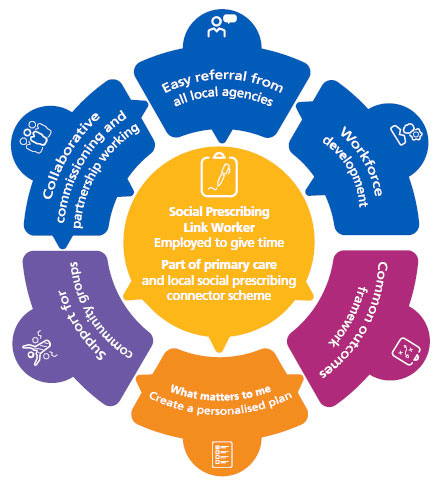What Is Social Prescribing Anyway?
The way we are thinking about health is changing a lot. That can be seen in the discussions we are having. both interpersonal and as a society, around mental health in particular. We can point to the fact that some brave and forward-thinking politicians called time on the legal discrimination that allowed mental health and physical health to be treated differently or the campaigners that paved the way. Still, it’s worth thinking about the way in which we all felt so led by that change and willing to try and drop the stigma. A lot of us anyway…
According to The National Academy of Social Prescribing:
Social prescribing started in Ireland as a ground up movement in partnership between the health service and community voluntary sector.
In short, Social Prescribing tries to address ill-health through non-medical interventions.
What Is It?
Social Prescribing aims to do what it says on the tin by linking clients with community-based activities and/or support services, tailored to the client by understanding what it is that brought them to a doctor to begin with, looking at what is available, and by understanding what is important to the client. Crucially, it is not about what the Social Prescriber thinks should be focussed on.
It is not just about being anti-medicine, or about reducing pressure on medical appointments—the truth is there is a huge evidence base that points to pioneering exactly this approach. We already know that multi-modal management is key to addressing any health problem, especially chronic ones. Social prescribing recognises the vital role of social determinants in health outcomes and proactively addresses them.
Sounds Good; Where Did It Come From?
General Practitioner Dr. Michael Dixon, who was based in the UK, came up with a novel idea. He prescribed activities like arts classes, gardening, and volunteering alongside medication, recognising that many patients' needs couldn't be adequately addressed by medicine alone. These days you might hear ADHD professionals, as an example, talking about multi-modal management—medication PLUS skills, or PLUS counselling, etc. It all started here, really. Formally, anyway.
How Can It Help Young People?
While social prescribing benefits individuals of all ages, the way in which it has been commissioned as, until now, been focused almost exclusively on adults. Every Primary Care Network—that is NHS speak for ‘one really large or two or more small GP practices’—should have a Social Prescriber employed by them, but they might only work with people aged 18 and over.
That being said, its impact on young people can be very noteworthy. Not just because Adolescence and young adulthood represent critical stages marked by significant physical, emotional, and social transitions that are marred with unique and changing challenges, like academic pressures, social media influences, and mental health issues—but because a lot of Child and Adolescent Mental Health Services (CAMHS) are reporting waits for a first appointment of 52-104 weeks.
In light of all of these challenges, social prescribing offers a personalised approach to addressing these challenges by providing young people. It does this by taking time and listening: why is this young person here? What do they care about? This is (I am sorry, parents) often very different to what parents think they ought to be. A typical client might be a teenager grappling with anxiety. A Social Prescriber might connect them with a mindfulness group, or they might connect them with a Peer Support Group of teens going through similar challenges. Similarly, a young adult experiencing social isolation might thrive in a community gardening project or a sports team—this will depend on their interests, and what they are hoping to benefit from after seeing you.
Other than resolving immediate mental health issues that are presenting, the benefits of Social Prescribing as a public health approach are obvious: more social connectedness, healthier behaviours, nurturing personal development, supporting the development of essential life skills, more resilience, and a sense of belonging—creating healthy adults in the future.
My GP Surgery Doesn’t Have a Social Prescriber—Can you help me?
I can try! Get in touch:
Final thoughts
The need for healthcare innovation has never been greater. In this context, Social Prescribing stands as a building more and more capacity for supporting children, teenagers. Unlike traditional medical approaches, it can be holistic in its scope, and it can redress the balance of power between the client and the practitioner, which has always been a challenge in healthcare.
By leveraging community resources and fostering holistic approaches to health, Social Prescribing has the power to be transformative. has the power to transform lives, particularly for young people who are still deciding who and what they will be.
Did you like this post? Think you have a friend who might want to read it?
Make sure you don’t miss any of my other posts:





